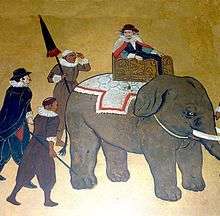Filipe de Brito e Nicote
| Filipe de Brito e Nicote | |
|---|---|
 | |
| Born |
C. 1566 Lisbon, Kingdom of Portugal |
| Died |
1613 Syriam, Burma |
| Nationality | Portuguese |
| Occupation | Adventurer, mercenary, governor |
Filipe de Brito e Nicote or Nga Zinga (Burmese: ငဇင်ကာ, pronounced: [ŋə zɪ̀ɴkà]; b. circa 1566, d. April 1613) was a Portuguese adventurer and mercenary in Rakhine (Arakanese) service.
Born to a French father in Lisbon, Portugal, de Brito first traveled to Southeast Asia as a cabin boy.
He eventually served under Min Razagyi, King of Arakan and became governor of Thanlyin (Syriam) in 1599, commanding 3 frigates and 3000 men. He encouraged more Portuguese to settle in Syriam and constructed forts for defense, eventually seizing control and renouncing his independence from Arakan. He captured Min Khamaung, crown prince of Arakan when Toungoo and Arakan attacked, keeping him hostage until granted independence from any Burmese in 1603. De Brito then married the daughter of Bannya Dala of Martaban, becoming a subject of Siam.[1]:185–187
Returning to Goa the next year to gain official recognition, he returned in 1602, awarded the titles "Commander of Syriam", "General of the conquests of Pegu", and "King of Pegu" by the Portuguese royal court.
Ekathotsarot mobilized Bannya Dala and de Brito to come to the aid of Toungoo, when attacked by the Ava Kingdom, and after Natshinnaung had asked to be subject to Siam. Before they could arrive however, Toungoo had submitted to the King of Ava. Bannya Dala and de Brito then burnt down Toungoo and brought back any remaining property and people, including their King, Natshinnaung, back to Syriam. De Brito took the opportunity of "seizing objects of worship of the Buddha" and "committed sacrilege to the point of forcibly demolishing Buddha images and sacred shrines and pagodas."[1]:188–189
In 1613, de Brito's Syriam was besieged by the Burmese forces of King Anaukpetlun. After the fall of the city in April 1613, de Brito was executed along with Natshinnaung. More than 400 Portuguese were taken as prisoners of war back to Ava.[1]:190
References
External links
- Danvers, Frederick Charles, The Portuguese in India. London, 1966.
- Harvey, G. E., A History of Burma. n.p., 1967.